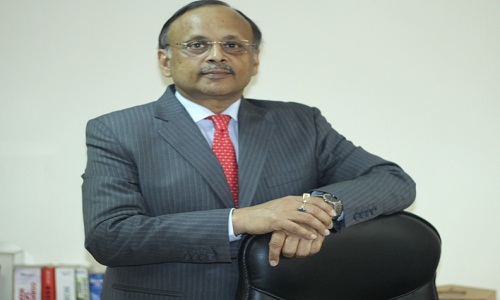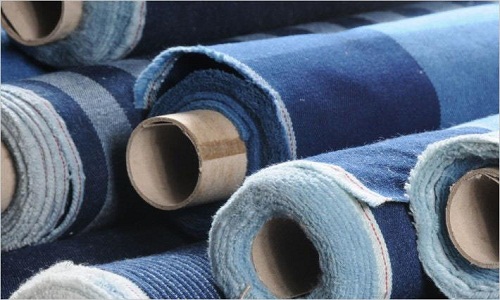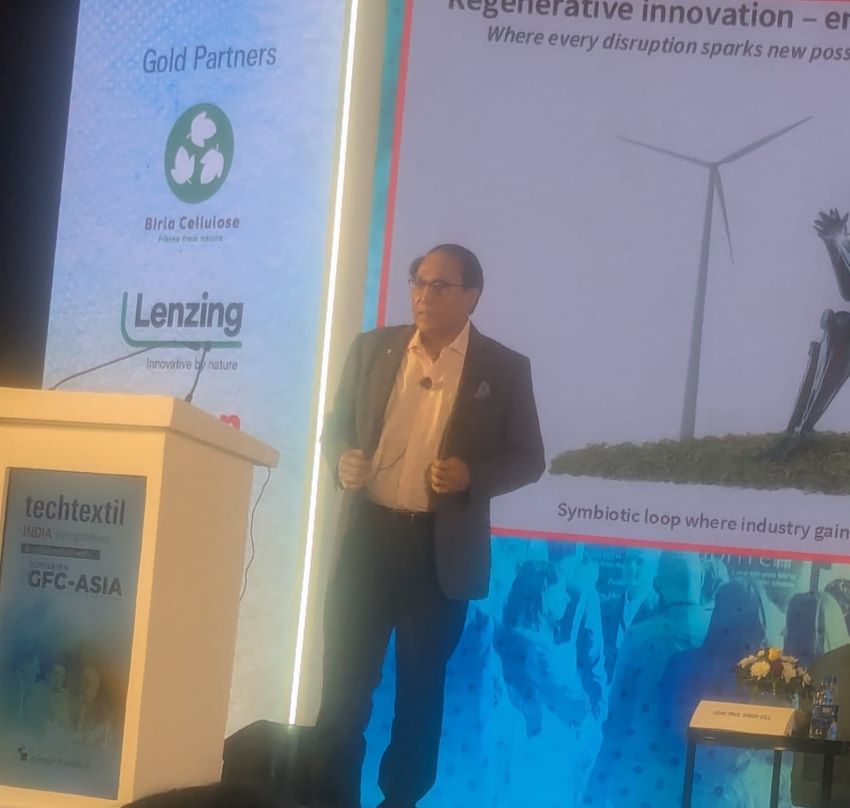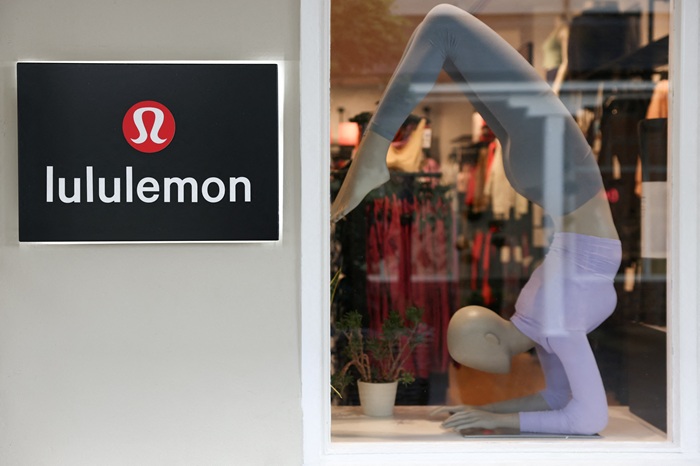FW
"After years of deliberation, the goods and services tax (GST), touted as the biggest tax reform in Indian history since independence, finally saw light. GST is expected to reduce distribution costs of retailers, improve the speed to market and boost overall consumption. And as Kumar Rajagopalan, CEO, Retailers Association of India opines the GST will reduce distribution costs and wastages as cascading effect of taxes will go."

After years of deliberation, the goods and services tax (GST), touted as the biggest tax reform in Indian history since independence, finally saw light. GST is expected to reduce distribution costs of retailers, improve the speed to market and boost overall consumption. And as Kumar Rajagopalan, CEO, Retailers Association of India opines the GST will reduce distribution costs and wastages as cascading effect of taxes will go. And speed to market would increase, as retailers can produce wherever and sell wherever to meet demand of consumers. More importantly, the availability of products will improve.
GST a great leveler

Many in the industry say retailers can centralise their storage and supply chain as GST aims to remove the complexity of multiple state and central taxes and a multitude of exemptions and ensure a seamless flow of input tax credit in the value chain. GST is expected to impact and shape-up India’s $16-billion e-commerce industry. Similar to the European Union, the politico-economic union of 28 states, a singular tax structure across the country will simplify inter-state transfer of goods, ensure merchant compliances and lead to easier tax refunds. For startups, which are already grappling with fund-raising issues, GST will take off the burden of complicated tax frameworks, which are currently different for every state. “E-Commerce companies will not have to struggle with the complex regulatory structure. Moreover, sourcing, distribution and warehousing strategies, which are currently designed by companies from the perspective of minimising the tax liability, will undergo a change,” a Delloite report said.
GST will also boost manufacturing, especially for small and medium enterprises (SMEs). Manufacturers pay 15 types of taxes, which will now be replaced by one tax. In the short term, however, there is likely to be some cost impact. SME manufacturers, currently exempt (if annual taxable turnover is up to Rs 1.5 crore) from paying excise duty, would have to pay the full taxes if GST is implemented.
Meanwhile the man-made textile segment, long neglected by policy makers, finally expects a ‘level-playing field’ vis-a-vis cotton textiles. At present, while man-made fibers attract a 12 per cent excise duty, cotton fibers attract none. This duty disparity has distorted the domestic consumption pattern in favour of the cotton fiber, contrary to the global trend. Although the actual GST rate applicable to textile and garment products will be announced in due course, senior textile industry executives say the current disparity in excise duty rates of cotton and man-made fiber will be ‘erased,’ unless the government decides to give some exemption to cotton fibers. Industry experts expect a GST rate of around 15 per cent, if the peak rate is 18 per cent, arguing that textile and garments are essential items.
According to the noted textile expert DK Nair, who is also an adviser to South Indian Textile Mills Association, man-made fiber-based products will be more competitive vis-a-vis textiles items based on cotton fiber. This will be a good policy push, in sync with the global realities. However, both cotton and man-made fiber are also subject to 4-5 per cent state VAT, which will be subsumed by the GST.
However, if the duty treatment of all cotton and man-made fibers remains the same, prices of textile items made of cotton fiber could raise a tad, Nair added. But equal tax treatment will give a push to man-made fiber production and subsequent exports.
The industry has long been complaining that the duty disparity is preventing domestic producers from scaling up operations and, consequently, hurting India’s export competitiveness in man-made textiles. This is because while man-made fibers account for around 70 per cent of the world’s total fiber consumption, they make up for less than 30 per cent of India’s demand.
Recently, the government announced radical changes to labour laws, apart from some concessions to the garments sector, aimed at boosting exports of textiles and garments by $30 billion over the next three years from $40 billion in 2015-16. Last year, the textile ministry had recommended a reduction in the excise duty for the man-made textile sector to 6 per cent from the current 12 per cent. But, such a step was never approved by the government.
GST is a comprehensive tax levied on manufacture, sale and consumption of goods and services at a national level. Under GST there will be no difference between goods and services. GST tries to eliminate indirect taxes and mitigate cascading or double taxation issues and leads to a common national market, with elimination of state boundaries.
The present cumbersome tax system puts challenges to the manufacturers, distributors and retailers. GST aims to minimise the hitches in double taxation: primarily eradicating cascading tax and smoothing the flow and structure to make it more seamless and organised. GST would also help to restructure interstate transactions. It will focus on streamlining the taxation methods at different levels across all the states in the country and between the states and central government.
J Suresh, MD & CEO-Arvind Lifestyle Brands Ltd & Arvind Retail feels, there are two impacts. One is in terms of the rate, whether the rate will go up or not. It is okay as long as it's up to 18 per cent. The current recommendation is 18-20 per cent only. Since textile is not one of the heavily taxed categories, it could be in the merit rate as well. GST is likely to benefit industries which are largely unorganised.
Implementation of GST will reduce transaction cost of doing business, also reduce food wastage and bring down prices. Hence it will not only bring relief to the consumers, but also help retail sector and building supply-chain efficiencies in India in a big way. This is thus a win-win legislative reform for all.

Sharad Jaipuria, the CMD of Ginni International is also the President of Denim Manufacturers Association of India, where most of India’s denim fabric manufacturers are members. Optimistic about domestic denim industry Jaipuria is also wary of too many new players coming into the fray. He speaks to Fashionatingworld about the challenges facing the Indian denim industry.
What are your business expectations from the oncoming Festive/Winter season and in the long term say next two to three years?
Denim production in India is growing at a CAGR of over 15 per cent per annum and presently India has a capacity of 1.3 billion meters of denim fabric. Also many new denim mills are coming up and expansions is taking place. This is likely to cause pressure in the domestic denim market. We expect demand for denim to grow at 12 -15 per cent for the next 2-3 years. With changing lifestyles, jeans are becoming popular in small cities and villages. Mills that are vertically integrated and focus on development and customers will continue to do well. We at Ginni Intl are concentrating on innovation, customer service and exports to stay competitive.
Give a peek into your product basket. What are the new products to be added?
Our product basket ranges on weight category between 5.0 oz.-14 oz, which is suitable for men, women and kids’ wear The products are a mix of spandex and non-spandex made of cotton , cotton-Tencel , dual core , poly viscose, yarn dyed etc. The customer today is very aspirational and therefore, we have to continuously add new qualities to our products. We have invested heavily on finishing and are offering denim finishes with peach, overdyed, brushed, coated, combination of two finishes and other chemical and mechanical finishes. Also, we are adding a printing facility soon. We are also innovating in weaving with various knits and dobby designs.
What is your capacity, current market size, in terms of volume annual growth rate?
Our present capacity is 28 million meters per annum in denim fabric, which is around 2.15 per cent of the country’s capacity of 1.3 billion meters. We make value added denim/premium denim fabrics only. In terms of distribution across channels : domestic RMG that includes brands/manufacturers/garmenting sector, manufacturer exporters make up 80 per cent; fabric exports (direct or merchant export) make up 20 per cent.
In terms of products, which kind of fabric is more in demand in domestic garment industry? What are current international trends?
The general demand is in comfort fabric with good stretch having variation in knits and dobby designs with different finishes.
India’s RMG industry has evolved a lot over the time, how do you focus on this segment?
We have a separate team to handle the domestic market, brands and exports. Presentations are planned, as their timing would be different from other channels. Our product development team develops products for exports, brands and domestic market separately for Spring/Summer and Autumn/Winter based on the feedback of our marketing team.
Do you have any major points of attention concerning this sector?
Large capacity is coming up within a short span of time which is putting pressure on denim industry. Also, exports growth is slow as large customers and retailers want packed garment and not fabric. India, unfortunately, has lost out in the race to have large scale organized garmenting like Bangladesh, Vietnam, Sri Lanka, Pakistan etc.
What kind of challenges are being faced by the domestic RMG sector now? The growth of RMG sector is complementary to denim fabric. More the growth in RMG, more the production of denim fabric as it helps in value addition.
Rwandan beneficiaries of the African Growth Opportunity Act (AGOA), a trade preference program of the US and select African counties, has called for easier access to US visas claiming that the rigorous process has kept them out of the market. The call was made when officials from the Trade and Industry ministry, Rwanda and US Ambassador to Rwanda, Erica Barks-Ruggles launched the renewed AGOA action plan a year after the US government decided to renew the free trade framework for sub-Saharan African countries by 10 more years, beginning 2015.
Although the number of Rwandan exports to the US remains relatively low compared to other African countries such as Nigeria, Angola, Kenya and South Africa, traders say there is need for more technical support from the Rwandan side and mitigation of the lengthy bureaucracy in acquisition of visas on the US side.
According to Gilbert Kubwimana, the Country Director of Songa Designs, a company that makes Rwandan-made jewellery for sale in the US, the cost of transactions and shipping has been a hurdle besides unreliable clearance freight agencies. Established in 2000, AGOA is the flagship of US trade engagement with Africa, the mandate of which was renewed by US executive despite calls by Congress to terminate it in the interest of the US economy.
However, according to Francois Kanimba, the Minister for Trade and Industry, re-launched AGOA Rwanda chapter will help traders unlock the potential of the US market although the priority has always been to first supply the local and regional markets.
Under the Generalised System of Preferences (GSP) program, approximately 5,000 products from 122 developing countries and territories, including 43 least-developed countries, are eligible for duty-free treatment when exported to the US. Nearly 1,500 of these are reserved for duty-free treatment for only least-developed beneficiary developing countries.
Environmental group Stand.earth wants Levi Strauss & Co. to step up its efforts to reduce pollution and increase the use of renewable energy across its entire supply chain.
The campaign wants Levi’s to make a leadership-level climate commitment for the full supply chain to meet or beat the Paris Climate Agreement, a 30 per cent to 40 per cent reduction in total greenhouse gas emissions by 2025. The campaign also calls for the company to transition its entire supply chain to renewable energy, with a minimum of 50 per cent of energy sourced through renewables by 2035, and a long-term carbon emission reduction target of 66 per cent by 2050.
Stand.earth believes Levi’s can catalyze the demand for renewable energy in China and India and accelerate the shift away from coal and other fossil fuels.
Coal is the top source of electricity in the company’s factories. Levi’s works with 170 factories in China, where coal powers 70 per cent of the electrical grid, and in 44 factories in India, where coal powers 75 per cent of the electrical grid.
Levi’s aims at 25 per cent reduction in greenhouse gas emissions at its US offices, retail and distribution centers. On the manufacturing side, Levi’s is working toward a five per cent annual reduction in greenhouse gas emissions per product shipped from company owned and operated plants by 2020.
While farmers in parts of Punjab have started uprooting cotton crop fearing attack of the whitefly pest, officials from the State government and the Centre are regularly visiting the cotton-belt to monitor the situation.
The pest attack, which caused extensive damage to Bt cotton crop last year in Punjab and Haryana, had been reported to be present this year too in a few villages of Malwa region mainly Fazilka district of Punjab. Farmers are worried that there could be increased infestation if the current hot and humid weather conditions continue to prevail for the next 15-20 days. Meanwhile, an increase in jassid pest attack which also sucks the crop like whitefly is worrying farmers in parts of Mansa and Bathinda districts.
After facing farmers’ wrath in the poll-bound State last year, ruling Akali government and the Centre are taking no chances. A steam of officials and experts touring the cotton belt for surveillance held a review meeting Jasbir Singh Bains, Director, Punjab Agriculture Department said that his department has been able to control the spread of whitefly this season as it was limited to 132 acres in a few villages. But the next 20 days or so are critical. If it rains, it will be good for the crop. Bains is a part of the expert team.
Whitefly attack caused extensive damage to Bt cotton varieties last year in Punjab and Haryana, resulting in a drop of nearly 40 per cent in production. Bt cotton accounted for over 98 per cent of the total cotton sown last year in both the States. The remaining two per cent was the indigenous cotton varieties. This season too, Bt cotton accounts for over 93 per cent of the total cotton sown. After the losses they suffered last year due to whitefly attack, farmers in both Punjab and Haryana have planted less cotton this year. In Punjab, the area has shrunk from 4.50 lakh hectares last season to 2.56 lakh hectares and in Haryana, cotton has been sown in 5 lakh hectares this year, against 5.80 lakh hectares last year.
Pakistan's GSP facility by the European Union and fluctuations in the value of local currency against that of major importing countries continues to take a toll on the country's terry towel and home-textile exports. Lower global demand for terry towel and home-textile products coupled with absence of necessary policy support from the government is also responsible for the situation, say experts. These factors have resulted in almost halving terry towel exports in the last five years.
Meanwhile, local terry towel exporters fetched only $47.80 million in the 2015-16 fiscal, compared to $92.11 million in 2011-12 fiscal. Earnings from the home-textile sector almost flattened in fiscal years 2012-13 and 2013-14, while it posted a 6.38 per cent negative growth in the last fiscal year. The industry fetched $753.01 million in the just-concluded fiscal year against $906.07 million in 2011-12 fiscal, according to the Export Promotion Bureau (EPB) data.
A study conducted in 2014 by Bangladesh Foreign Trade Institute (BFTI) apprehended that Bangladesh would likely face strong competitive pressure from Pakistan following the EU GSP facility and home-textile would be the main victim of the new system. The global demand for home textiles and terry towel products is slow following the financial crisis, while locally made products are facing stiff competition with those of Pakistan and India, according to Hossain Mehmood, chairman of Bangladesh Terry Towel and Linen Manufacturers and Exporters Association (BTTLMEA).
The textile industry is an important contributor to Kenya's economy, serving as a large source of jobs and export earnings. But Kenya’s apparel industry, valued at $330 million a year, is still small, with an estimated 30,000 workers, versus the $23 billion industry in Bangladesh that employs 4.2 million people. In Kenya, the industry comprises only six per cent of the small manufacturing sector.
However, the country is trying to grab a larger slice of the global clothing market. It has the best chance to do so in a few years, thanks to shifting global trends. It all boils down to China, which is no longer the factory of the world. Even when it comes to Bangladesh international buyers are reconsidering their strategies. People are very concerned about building safety in Bangladesh. While Africa has water, cotton, labor and green energy. Cotton exports from Africa account for about 13 per cent of the world's production. And unlike Bangladesh, African countries also have duty-free access to the US apparel market.
Foreign buyers, mostly from the US, are hoping to increase the volume of orders they place with Kenyan apparel factories. And Kenyans happen to be expert clothes makers. Some factories in Kenya already produce denim for H&M, Walmart and others.
For its sixth edition next year, Asia Apparel Expo 2017 will present collections from Asian outfits offering men’s, women and children’s wear as well as knitwear, fabrics and textiles, trimmings and accessories. The Expo will be held in Berlin from February 14 to 16, 2017. Currently, Europe imports nearly half of world's entire clothing production. With Asia being the major world supplier of garments today (accounting for 32 per cent), the Berlin-based trade show hopes to bring major manufacturers to one location making it simpler for European buyers to network.
China is the leading world producer and supplier of clothing while another six countries like China, Indonesia, Vietnam, Bangladesh, Sri Lanka and India account for 80 per cent of Asia's apparel exports to Europe, America and Japan. As per the organisers, over 300 companies are expected to participate in the show particularly from Hong Kong and China, as well as the other major apparel export producing countries like Bangladesh, Pakistan and India. On offer will be finished garments, contract manufacturing and private label development. Over 1,800 trade professionals are expected to attend the show, the organisers said in a statement.
Bangladesh is the second largest exporter of clothing after China to the world. The country’s global market share in clothing rose to 5.9 per cent in 2015; China’s share stood at 39.3 per cent; Vietnam is the third largest with 4.8 per cent share in 2015 from four per cent the previous year. India and Turkey jumped to 4.1 per cent and 3.4 per cent from 3.7 per cent and 3.5 per cent respectively. The global market size of readymade garment products is around $450 billion dollars.
Bangladesh needs over 13 per cent growth for achieving the $50 billion export target by 2020. In the last fiscal, Bangladesh earned $28 billion with over 10 per cent growth rate. A market share of about seven per cent within the next two years is possible as a result of additions to the country’s production capacity. The country has an enormous opportunity to enlarge its global market share as it has started producing higher- and medium-end products.
The fact that buyers are relocating their business from China is an advantage for Bangladesh. But to cash in on this shift, Bangladesh has to identify those relocating their businesses and build networks with them. Also non-traditional export markets are playing an important role in readymade garment exports.
The general secretary of Global Economist Forum-Bangladesh (GEF-B) Mamun-Ur-Rashid believes the recent terrorist attacks may erode investors’ confidence in the country. This could cast an adverse effect on the country’s ability to attract Foreign Direct Investment (FDI). He however, claims the government has been able to recover lost image by virtue of the strong action which will help foreigners keep confidence on the country. Rashid, who is also the Additional Managing Director of Standard Bank feels it is the most damaging of a series of attacks targeting foreigners and minorities in the past year and highlighted political risks that are factored into the government bond rating, through assessment that Bangladesh’s vulnerability to political event risks is moderate. Besides, prolonged political or geopolitical instability could erode investors’ confidence and a worsening of the external payments position, he said.
He pointed out that adverse trends in foreign investment would be particularly detrimental to garment exports, a predominant growth driver. Exports comprise 16.3 per cent of Bangladesh’s GDP and sustaining foreign investment in the textile sector which accounts for 80 per cent of the total export basket is crucial for growth. Moreover, Bangladesh is one of the few countries in Asia Pacific that has continued to record exports growth as global demand has weakened.
He also informed that between July 2015 and April 2016, Bangladesh’s total exports increased by 9.2 per cent year-on-year. Among the ones that powered the increase were pharmaceuticals, raw jute, knitwear and woven garments and engineering goods exports.













